

Evaluation of Online Formative Assessment in the Classroom: A Comparative Case Study of Kahoot and Socratives. 7 Shifts To Create A Classroom Of The Future. Tomorrow’s Learning Today: 7 Shifts To Create A Classroom Of The Future by Terry Heick For professional development around this idea or others you read about on TeachThought, contact us.
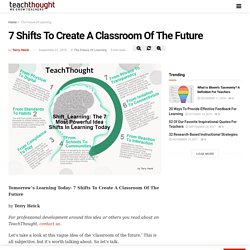
Let’s take a look at this vague idea of the ‘classroom of the future.’ This is all subjective, but it’s worth talking about. So let’s talk. Below are some ideas that are truly transformational–not that they haven’t been said before. And the best part? But therein lies the rub: Tomorrow’s learning is already available, and below are seven of the most compelling and powerful trends, concepts, and resources that represent its promise. The Challenge of Implementation It’s challenging enough to manage a traditional learning environment where the curriculum is handed to you, and meetings are set, and you’re simply there to manage; adding more ingredients to the mix seems like asking for trouble. How to flip the classroom using game-based learning. Paul Rogers, award-winning author of Little Bridge, explains how game-based learning helps teachers and students prepare for more productive and effective lessons.

Join his webinar on 25 February 2016. Effective learning happens when you are fully involved in what you are doing. Similarly, when you want to get the most out of reading a book or watching a film, giving it your full attention makes all the difference. But when you are learning, this is even more important, because the activity is not just receptive, but makes all kinds of demands on your memory and your understanding. If your mind is wandering, if you're bored, if you lose interest, the learning will not be effective and your motivation will wane. A class is made up of individuals with different needs. Mario Kart in the classroom: the rise of games-based learning. Apple have recently announced their new Textbook category in the iBookstore that offers students access to educational texts that can be highlighted, marked and searched without then passing on a dog-eared book to subsequent years.
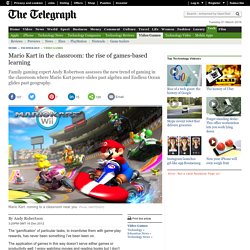
Speaking to Nathan Lowe at The Filtch Green Academy school, which has pioneered the use of technology in the classroom, I was surprised to hear of the level of investment both in terms of money as well as space in the school day. “We currently have 100 MacBooks, 20 iPod Touch and 80 iPads for our 210 children aged 4-11… We have found that with a creative approach to learning and teaching, our teachers have managed to integrate technology into all subject areas.” These are productivity tools rather than entertainment though, and much easier to justify in the classroom than video games.
Læringsopplegg. GIS HANDBOOK EN. Learn English or die: The effects of digital games on interaction and willingness to communicate in a foreign language. Learn English or die: The effects of digital games on interaction and willingness to communicate in a foreign language Hayo Reinders and Sorada Wattana Published Online: April 15, 2011Abstract | References | Full Text: HTML, PDF (528 KB) Abstract In recent years there has been a lot of interest in the potential role of digital games in language education.
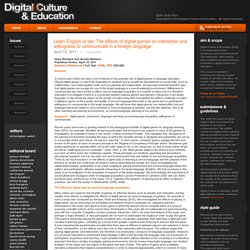
Playing digital games is said to be motivating to students and to benefit the development of social skills, such as collaboration, and metacognitive skills such as planning and organisation. An important potential benefit is also that digital games encourage the use of the target language in a non-threatening environment. Examensarbete. What Game Based Learning Can Do for Student Achievement. If I had written this article two years ago, it would have been very different.
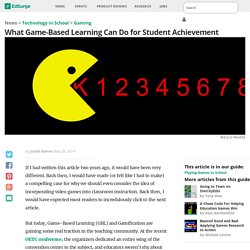
Back then, I would have made (or felt like I had to make) a compelling case for why we should even consider the idea of incorporating video games into classroom instruction. Back then, I would have expected most readers to incredulously click to the next article. But today, Game-Based Learning (GBL) and Gamification are gaining some real traction in the teaching community. At the recent OETC conference, the organizers dedicated an entire wing of the convention center to the subject, and educators weren’t shy about their interest. When I presented on the subject at Common Ground 14, I had the dreaded “last-presentation-of-the-day” spot, but I was very pleased at the turnout and interest. Before we go any further, let’s get one thing straight: Gamification vs. Gamification vs. Gamification refers to the adoption of game-like principles when working outside of a gaming context. Kids and video games: Why children should play more. Parents, politicians, and educators often criticize video games as a waste of time that distract kids from healthier activities such as school, outdoor play, sports, and community service.
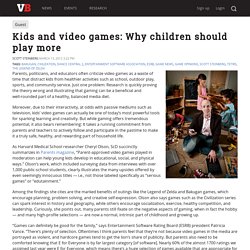
Just one problem: Research is quickly proving the theory wrong and illustrating that gaming can be a beneficial and well-rounded part of a healthy, balanced media diet. – Dataspilling gjør unge bedre i engelsk. Publisert 29.01.2016 — Det utdanningsvitenskapelige fakultet ved Universitetet i Oslo.

Game Based Learning - Why Does it Work?